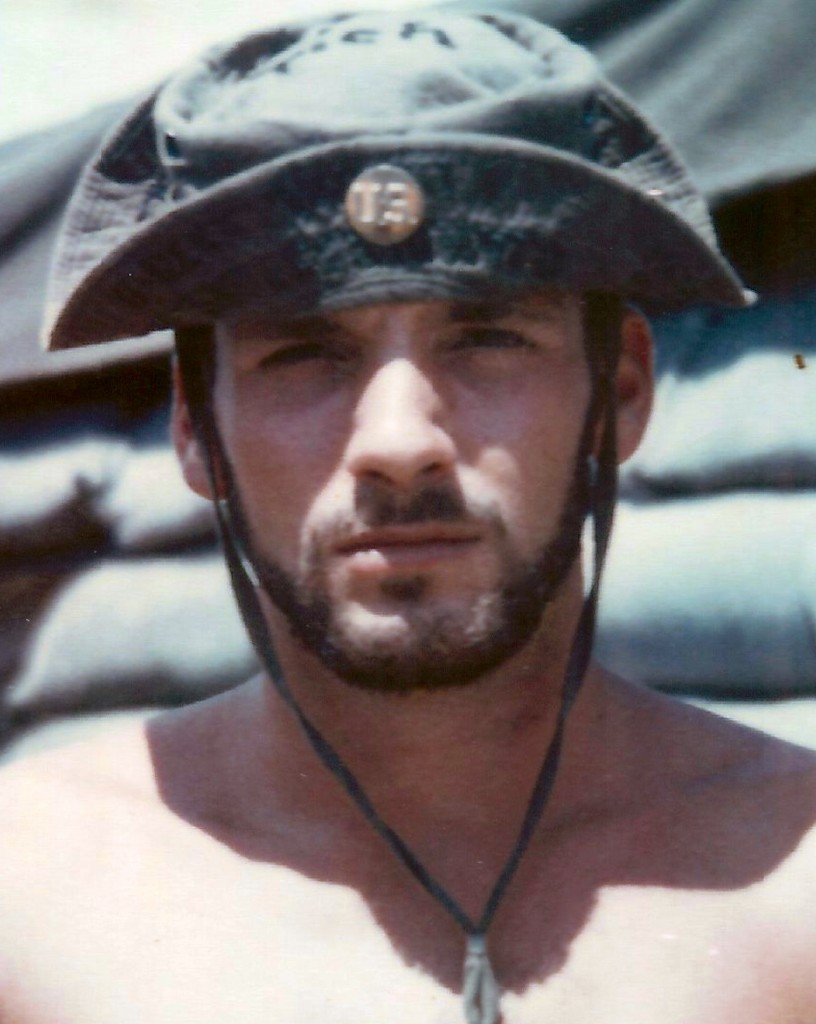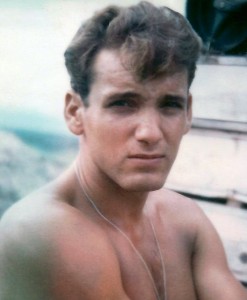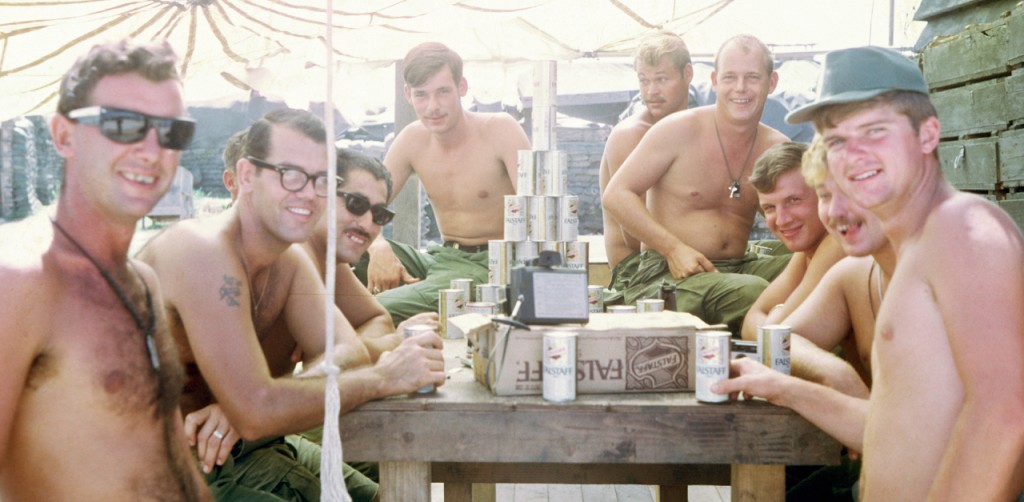Fifty years ago on November 3, 1965 the boys of Battery B arrived in Cam Ranh Bay with the 5th Howitzer Battalion/27th Field Artillery.
The 5th Battalion had been activated just two years earlier on June 20, 1963 at Ft. Lewis, Washington. At first it was an empty battalion with just a headquarters staff, and under orders to form three 105 mm howitzer batteries of six guns each. B Battery came into existence sixteen months later on October 29, 1964. John Santini, assigned to the battery as a gun crewman, says of that first crew:
The original B battery was like a melting pot of all different people. We had our stragglers, but B battery was a STRAC unit (Strategic, Tough and Ready Around the Clock). We could do any mission the Army wanted of us.
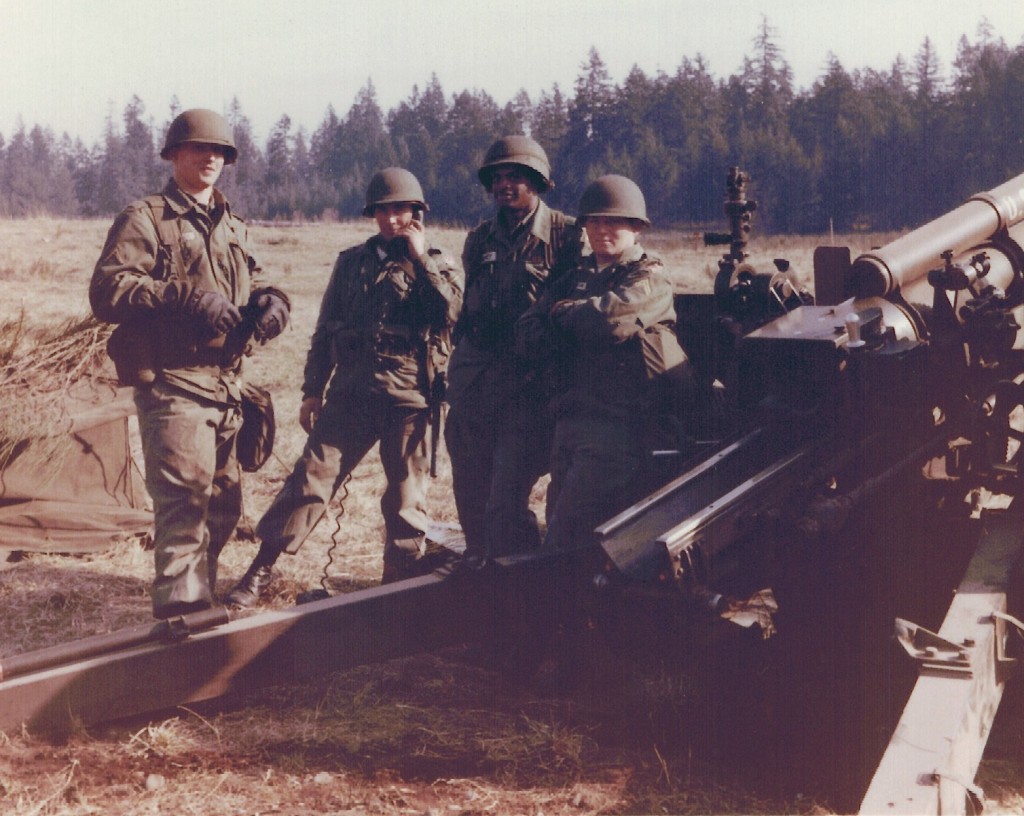
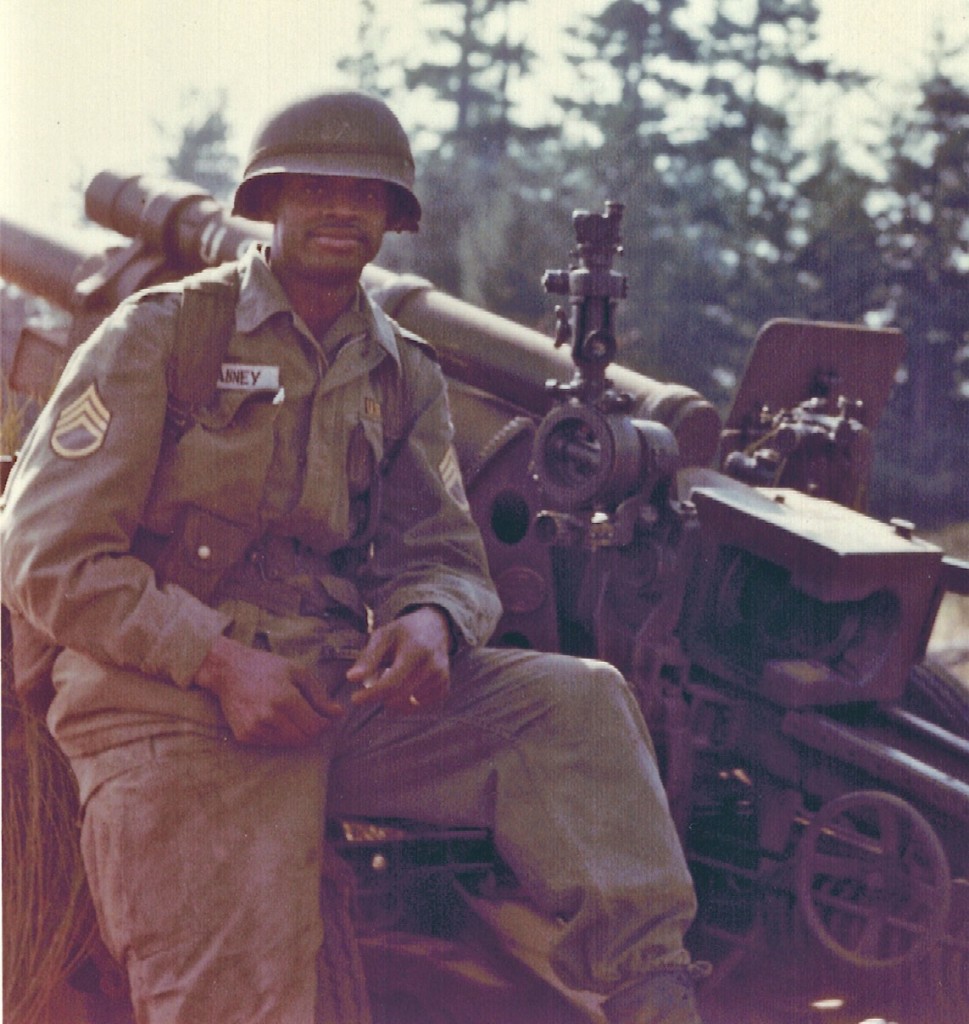
First B Battery Chief of Smoke
At Sea
B Battery was barely a year old when the battalion left for Vietnam in early October 1965. The battalion was staffed at 512 personnel (27 officers, 3 warrant officers, and 482 enlisted), four short of an authorized headcount of 516. John Santini describes the departure.
From Ft. Lewis we got on busses for Sea-Tac airport in Seattle. Walking through the terminal we were in full combat gear, with our helmets and M-14 rifles. People stopped and looked at us, some of them applauded. We boarded a plane and went to Oakland, California. As we were getting off the plane every one of those stewardesses lined up at the door and gave each man getting off the airplane a kiss – whether he was black, white, Hispanic, or whatever he was – and they were crying their eyes out. It was heartbreaking.
At Oakland men and equipment loaded onto a troop transport ship, the USS J. C. Breckinridge, and departed shore on October 10. John Santini captures the events of the crossing.
Everything was on the ship, our gear, the guns, trucks, everything. I think we stayed in port for a couple days. Then we were off. We went underneath the Golden Gate Bridge, looked up and it was the most beautiful bridge in the world. We went out on the ocean, and the official record says it took 19 days.
On board the ship we had to exercise on the deck until it got too hot. We did target practice with our M-14s out into the ocean to stay familiar with our weapons. And on the ship you had to work, you were given details. But I brown-nosed my way out of them. I would walk around and watch the Navy guys chipping away at the grey paint – chip it … paint it … chip it … paint it. That’s all they did: chip it and paint it.
I remember the good Navy food.
We used to go up on deck at nighttime and watch the waves. It was the scariest thing you’d ever want to see. Here you are a little ship in a gigantic ocean. You wouldn’t see a ship, nothing, for days. There was nothing out there. If that ship would have sank, you’d have died.
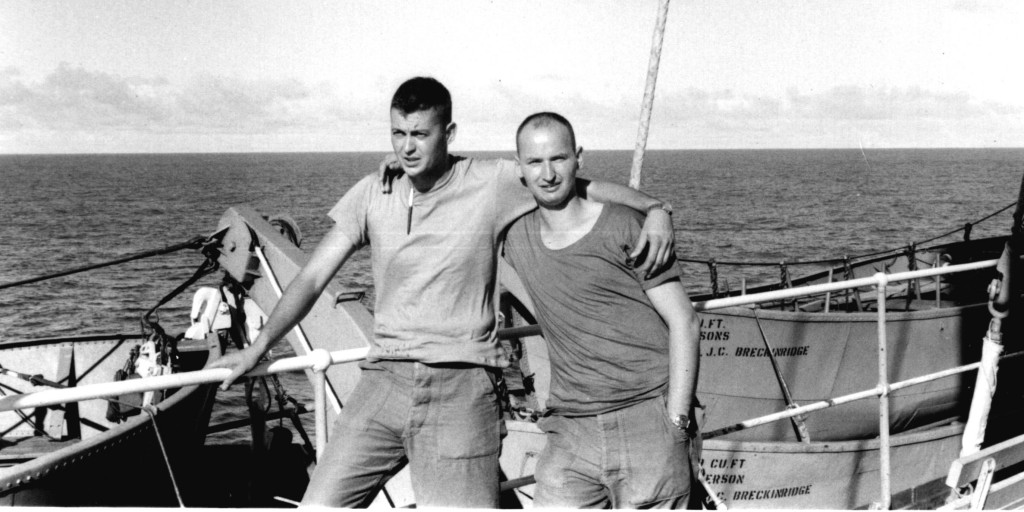
We had classes from Captain Johnson. He had been to Vietnam before and that’s why he was our captain. He was telling us how to stay alive over there, he was telling us about what to expect. We had classes about respecting the Vietnamese. Don’t go out there and fuck everything that walks, their mothers and daughters, don’t do stuff like that. They’re human beings, not sluts and trash. They want you to respect the culture. They want you to go in there and do your job and obey your commands and treat people right. They gave everybody a little card that I kept.
The ship broke down outside Hawaii, and it took two days for the swabbies to get it fixed. We never went into port there, you could see the island in the distance. Then we went on to Okinawa, where we stayed just one day. We were able to get off the ship and tour the city. From there we went to Vietnam.
The J. C. Breckenridge arrived at Cam Ranh Bay on November 3, 1965 but did not immediately touch shore.
We stayed outside port for two days. We were on the deck in our combat gear with live ammunition, still maybe 200 yards from the port. Some of us had the clips locked into our rifles, and they told us to remove them. They said, “As soon as you get on the ground, then put the clip in your gun.”
We left the boat on ramps, loaded the ammunition and equipment on five-ton trucks, and then hooked the guns behind the trucks. On our first day we joined the 101st Airborne Infantry at a rubber plantation off Highway 1 on our way up to Nha Trang. There we set the battery up and stayed for a little while.
First Fire Mission
We’re in Vietnam three weeks and it’s Thanksgiving day. We had our perimeter set up outside Nha Trang airport, we’re in combat mode, and we’re waiting around for orders.
Now everyone is bitching, because here it is Thanksgiving and we’re eating C-rations out of cans. Soon choppers landed and brought us a real Thanksgiving meal. We hardly started when a fire mission came in. A Special Forces unit was in trouble on a nearby mountain, they were pinned down. We started the mission before the sun went down with only a few rounds, but it went on for most of the night. That was our first combat mission, to support the 5th Special Forces on Thanksgiving of 1965.
The 5th Special Forces were the infamous Green Berets. Shortly after the 5th was activated for Vietnam in 1961, President John F. Kennedy personally authorized the distinctive green beret. The 5th SF became known for their unconventional warfare methods and were among the last to leave Vietnam.
The Proud Patch
Straight off the transport ship at Cam Ranh the battalion attached to the 1st Brigade of the 101st Airborne Infantry Division. This meant the battalion acted as a combat arm of the 101st Airborne, and as such its guys wore the Screaming Eagle patch of the 101st.
During those early months in Vietnam John Santini says there was so much chaos nobody worried about a patch, even if you could find one. Shortly however it became a standard part of the 5th Battalion uniform.
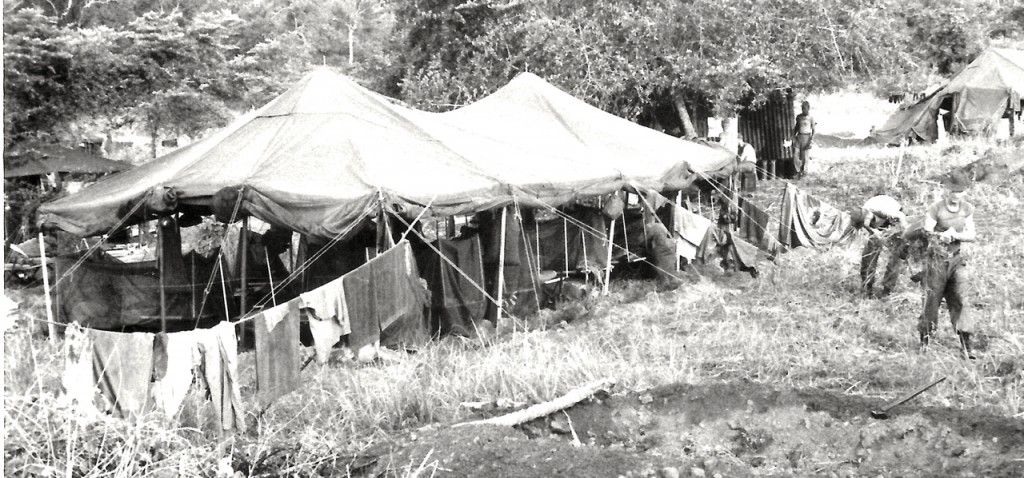
In January of 1968 B Battery joined a newly formed taskforce whose nucleus was four rifle companies of the 3/506, a storied 101st airborne infantry battalion known as the Currahees: Cherokee for We Stand Alone. The unit history of Task Force 3-506 calls it “a commander’s dream,” because under its operational control were over two thousand men comprising the full complement of land, sea and air assault forces. TF 3-506 operated out of Phan Thiet with the dual mission to conduct short-notice airmobile deployment into four contiguous provinces, and rapid airborne assault anywhere in Vietnam. Bravo Battery was one of three artillery batteries belonging to TF 3-506. It occupied landing zones north of Phan Thiet, first briefly at LZ Judy during the 1968 TET offensive, and then permanently at LZ Sherry.
For its support of the 3/506 during TET of 1968, under the command of Captain George Moses, B Battery would be awarded the Valorous Unit Award, the second highest decoration that can be given an Army unit and the equivalent of the Silver Star. B Battery was the only unit of the 5th Battalion to win the Valorous Unit Award in Vietnam.
When the 3/506 Currahees departed Phan Thiet in December of 1969 their patch went with them. Today B Battery veterans of those years display the 101st Screaming Eagle on caps, vests, jackets, and anywhere someone is likely to see that proud patch.
* Special thanks to John Santini for his commentary and pictures, and to Jerry Berry for historical background on Task Force 3-506.
